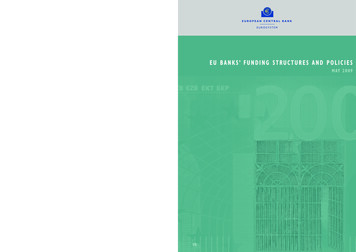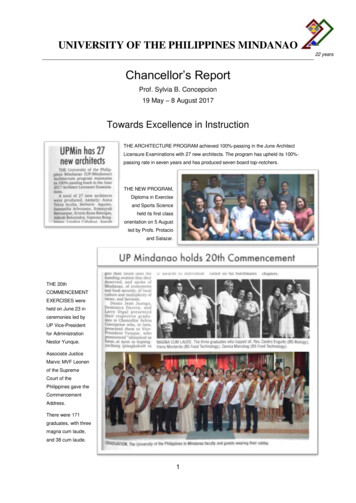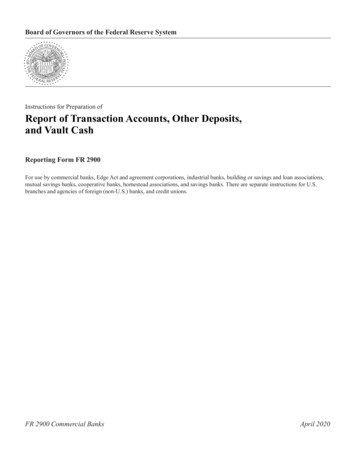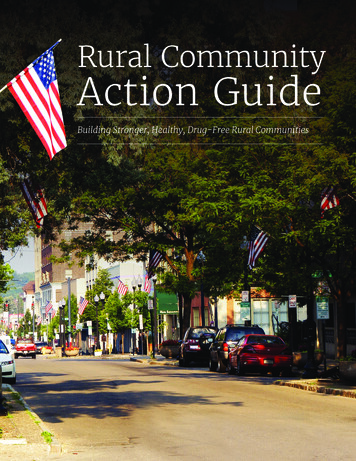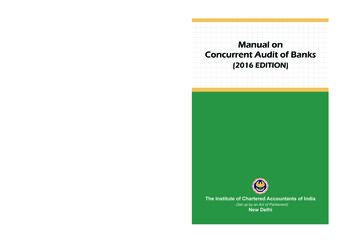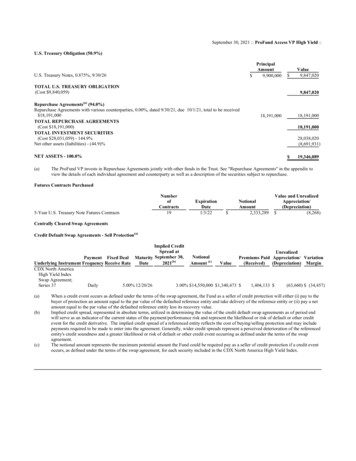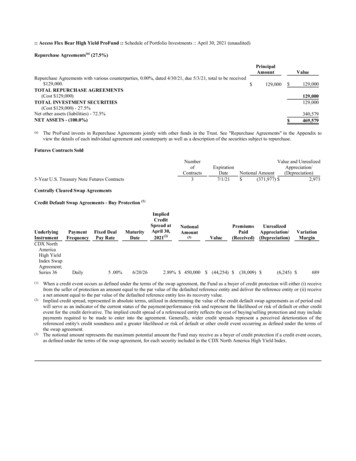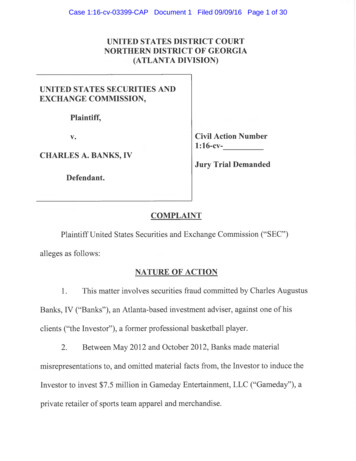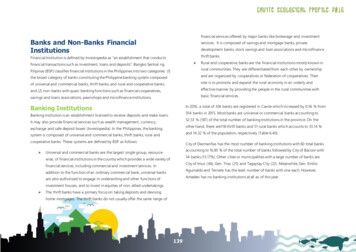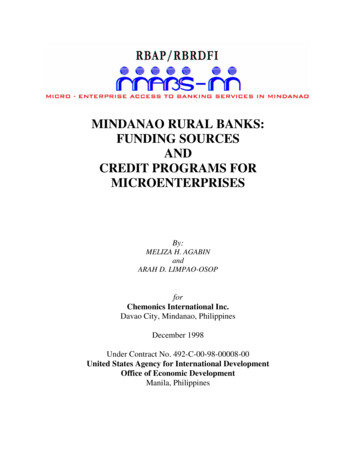
Transcription
MINDANAO RURAL BANKS:FUNDING SOURCESANDCREDIT PROGRAMS FORMICROENTERPRISESBy:MELIZA H. AGABINandARAH D. LIMPAO-OSOPforChemonics International Inc.Davao City, Mindanao, PhilippinesDecember 1998Under Contract No. 492-C-00-98-00008-00United States Agency for International DevelopmentOffice of Economic DevelopmentManila, Philippines
MINDANAO RURAL BANKS:FUNDING SOURCESANDCREDIT PROGRAMS FOR MICROENTERPRISESCONTENTSAbbreviationsExecutive SummaryIntroductioniii1I. Funds Sourcing1DepositsBorrowings24II. Programs for Microenterprise Finance4People’s Credit & Finance CorporationCharacteristics of Credit ProgramsStatus of the Lending Programs556Concluding Remarks7List of TablesTable 1: Sources of Loanable Funds, 1997Table 2: Structure of Deposits, 1997Table 3: Matrix of Information on Selected CreditPrograms for the Microenterprise SectorTable 4: Loan Terms & Conditions23812Annexes: Description of Funding SourcesPCFC: ADB-IFAD RMFPPCFC: HIRAMDTI-BSMBD: TST/NGO-MCPNLSFLBP: RPCFIQUEDANCOR: FAREUCPB-CIIF: EDCP (RFI-MCP)14172024273033
ABBREVIATIONSADB-IFAD HGSTDTST/SELA/NGO-MCPUCPB-CIIFUSAIDAsian Development Bank-International Fund for AgriculturalDevelopment Rural Microenterprise Finance ProjectBangko Sentral ng Pilipinas (Central Bank of the Philippines)Countryside financial institutionsDepartment of Trade & IndustryEnterprise Development & Credit ProgramsFood & Agriculture Retail EnterprisesGrameen Bank ApproachHelping Individuals Reach their Aspirations through MicrocreditIntermediary Financial InstitutionLand Bank of the PhilippinesMicroenterprise Access to Banking Services in MindanaoMicrofinance InstitutionNon-government organizationNational Livelihood Support FundPhilippine Business for Social ProgressPeople’s Credit & Finance CorporationProgram lenderPeople’s OrganizationPromotion of Small EnterprisesQuedan and Rural Credit Guarantee CorporationRural Bankers Association of the PhilippinesRB Research and Development FoundationRural Financial InstitutionsRediscounting Program for Countryside Financial InstitutionSelf-help groupSpecial time depositTulong sa Tao/Self-employment Assistance Livelihood/Nongovernment Organizations for MicrocreditUnited Coconut Planters Bank-Coconut Industry Investment FundUnited States Agency for International Development
MINDANAO RURAL BANKS:FUNDING SOURCES ANDCREDIT PROGRAMS FOR MICROENTERPRISESEXECUTIVE SUMMARYThis research brief looks briefly at the funding sources of Mindanao rural banks, and presents selectedcredit programs that wholesale funds to rural banks for microenterprise finance. The funding structure ofMindanao rural banks, the important changes that had occurred, and the relative importance of deposits,networth and borrowings are discussed. Six credit programs targeting microenteprises and the poor areincluded in this brief. A detailed profile of each program is in the Annex.The purpose in presenting the credit programs is to inform rural bankers interested in expanding theirmicroenterprise portfolio, and need to augment their resources to do so, which programs they could tap.The judgment call on which program would be appropriate and helpful to their bank rests entirely on themanagement of each bank. In the final reckoning, deposits are still the more viable, reliable and cheaperfunding source for a bank.Important highlights are as follows: Deposits are a primary source, but Mindanao rural banks lag behind the industry average, andneed to do more. Small savers, 9 of 10 depositors, are the major suppliers of credit funds, providing more than athird of total loanable resource. Deposit taking policies and practices favorable to small savers could potentially generate more,but Mindanao rural banks need to overcome their laid back approach, and learn to promote theirservices more aggressively. A few innovators are designing products and actively promoting their deposit services, but theirtribe has yet to increase. Capital accounts, second in importance to deposits, have grown well enough on account ofimproved profitability (till 1997), and increase in capital requirements. Mindanao rural banks borrow P0.20 out of every P1.00 loanable fund, and tend to borrow morethan the average in the industry. They have diversified their sources of borrowings and nowaccess commercial sources, too. LandBank and BSP are important sources for their agriculturalloans. Borrowing from credit programs does not appear to be much. A sprinkling of rural banks inMindanao have taken loans from programs for microcredit and/or microenterprises. The People’s Credit and Finance Corporation (PCFC) is currently the most important provider ofwholesale funds for microlending. It has two programs. The bigger one, with ADB-IFADfunding, lends only to replicators of the peer group lending methodology of Grameen Bank. This
inflexibility, inherent in the program design, slows down program implementation. Mindanao shares about one-fifth of the credit program activities, in terms of funds and clientelereached. Most lending programs price their loans based on market rates. Some programs offer long-termloans as well as soft loans to support operating expenses. Constraining factors on the ground and at the level of the retail institutions slow down programimplementation and restrain expansion.In conclusion, a lot of money is available from credit programs. Rural banks seriously wanting to increasetheir portfolio for microenterprises, and need to augment their resources to do so, have options to choosefrom. Nonetheless, rural banks should view these programs as a temporary aid to expand their loanportfolio to the microenterprise sector to a profitable and sustainable level. Program funds are not asubstitute for bank effort to generate more deposits; rather, rural banks should use such funds to helpthem develop their deposit clientele base and credit markets.ii
iii
MINDANAO RURAL BANKS:FUNDING SOURCESANDCREDIT PROGRAMS FOR MICROENTERPRISESINTRODUCTIONThe number of rural bank outlets in Mindanao had grown remarkably by fifty percent more since 1994principally on account of rapid branching over the last three years or so. This growth in physical outletswas matched by a relatively modest rise in total resources whose structure had shifted, during the nineties,in favor of internally generated resources. This is a stark contrast to what it had been in the seventies andthe eighties.This research brief comes in two parts, and intends to do the following: take a quick look at the funding sources of Mindanao rural banks; and present selected credit programs that provide wholesale funds to intermediary financialinstitutions (IFIs) for the microenterprise and other low income sectors.The intention in presenting the credit programs is to inform rural bankers interested in microenterprisefinance about programs they may access for augmenting their resources. Rural banks have learned wellenough from their past experiences with directed credit programs to weigh, and discern, what programswould be helpful or harmful to their banks. In the final reckoning, deposits are still the more viable,reliable and cheaper source of funds for a bank. Gathering more deposits is what the programMicroenterprise Access to Banking Services in Mindanao (MABS-M) would like to encourage ruralbanks to do. MABS-M is a four-year program to develop the capacity of rural banks in Mindanao toexpand its deposit and credit services to the microenterprise sector. It is a joint project of the RuralBankers Association of the Philippines (RBAP), the RB Research and Development Foundation(RBRDFI), United States Agency for International Development (USAID), and the Government inMindanao.I.FUNDS SOURCINGAt the end of 1997, rural banking had grown into a P57 billion asset industry that had at its disposal someP53.0 billion worth of credit resources. Around 136 Mindanao rural banks, 1 comprising less than 15percent of the industry’s assets and lending funds, had about P6.3 billion loanable resources in theirbooks. These credit funds come from deposits, borrowings, owner’s capital, and undivided profits. In thebalance sheet of some rural banks, there is a minor item there called non-reserve deposits. These are1The June 30,1998 data of BSP’s Special Reports and Studies Office (SRSO) show 158 head offices and157 branches of rural banks in all of Mindanao. This head count, however, includes some banks no longeroperating. It should be noted that rural banks in Mindanao, as in the rest of the country, had been expanding theirreach through branching than in setting up new units.1
composed of special time deposits (STDs) from credit programs, mostly from the past, and specialdeposits in the name of village associations.Table 1 shows us the funding structure and how each component had grown in recent years. It reveals theprimacy of deposits in the present sourcing of funds, and the relatively more important role of capitalaccounts for Mindanao rural banks. Capital accounts had grown well enough due to an increase in thecapital requirement as well as improved profitability at least until 1997.Table 1. Sources of Loanable Funds, 1997Amount(in Million Pesos)SourcesPercent Share to TotalTimes Increase (X)1997/1995All RuralBanksMindanaoRBsAll RuralBanksMindanaoRBsAll 3XNon-reservedeposits52.27.60.10.10.50.2Bills payable7,508.41,265.614.219.91.71.4Capital ,372.1100.0100.01.61.4DepositsSource of basic data: SRSO, Bangko Sentral ng PilipinasDeposits Deposits are a primary source, but Mindanao rural banks lag behind the industry average, andneed to do more.Deposits have largely replaced the cheap funds that government directed credit programs used to supplyin abundance to rural banks in the seventies and eighties. Industry-wide, deposits were 70 percent of thetotal credit resources, while in terms of the ratio of deposits to total loan portfolio, 90 percent in 1997was a far cry from what it was in 1980 (36 percent).Mindanao rural banks fall behind the industry average as regards deposits generation. Their depositscomprised merely 56 percent of the total credit resources, and the ratio of deposits to loan portfolio (65percent) was far lower than the industry average. Small savers (regular savings account holders) are the major suppliers of funds, providing P0.36out of every P1.00 loanable resource of Mindanao RBs.Based on the BSP data, rural banks nationwide were serving as much as 1.7 million savers in 1997,2 with2Using number of accounts as proxy. It is likely that some borrowers hold more than one account. This isignored at the moment.2
Mindanao rural banks reaching close to 300,000 savers. These figures though appear to understate thenumber of people depositing with rural banks. In any case, our estimate of the number of savers is two tothree times those that borrow. Some Mindanao rural banks reach as much as six times their borrowers.Looking at the structure of deposits, 9 out of 10 depositors hold savings deposit account, and providemore than half of the total amount of deposits. This is true for the whole industry as well as Mindanao.The more expensive time deposits had been growing in importance, too, while demand deposits, thoughrising, are still a minuscule portion since only a few Mindanao RBs have checking account services.Table 2. Structure of Deposits, 1997Amount of deposits (in P million)Percent share, by type of depositType of DepositAll Rural BanksMindanao RBsAll Rural BanksMindanao 00.0100.0Source: SRSO, Bangko Sentral ng Pilipinas Deposit taking policies and practices favorable to small savers could potentially generate more; todo so, however, Mindanao RBs need to promote and market their services.Given their policies and practices in deposit taking, rural banks are reaching a segment of the financialmarket that cannot otherwise access the services of the big banks, and there is still a big potential marketfor them out there. Compared to other banks, rural banks generally accept much smaller amounts to openand maintain an account. It usually takes only P100 to open a savings account; some rural banks acceptamounts as low as P50. Below the minimum maintaining balance, a few banks even waive penaltycharges. For a time deposit account, P1,000 minimum is common. Because of these practices, it is easyfor rural banks to serve savers that include school children, public market vendors and small shop owners,tricycle drivers, members of self-help groups, and the like.Rural banks in Mindanao also tend to pay higher rates to their depositors than commercial banks do.Their interest rates on savings deposits, which are normally 5 to 6 percent, are 2 to 3 percentage pointshigher than what commercial banks pay. On time deposits, rural banks also match or pay more thancommercial banks.Lacking aggressive promotional campaigns, Mindanao rural banks tend to take a laid back approach ofwaiting for depositors to come in and/or requiring their borrowers to have a deposit account with them. Itis fairly common for rural banks to solicit and pick up deposits daily in public markets and commercialcenters. For practical reasons, their deposit pick up services appear to be confined to areas that are inclose proximity to the bank. However, there are also those that are more innovative and aggressive inmarketing their services, although their tribe has yet to increase.3
The following are examples of some creative practices we found in the field: using the traditional piggy bank to encourage depositors to save up tiny amounts as often aspossible in his/her own “bank”, and to deposit the amount so saved with the rural bank; tapping school officials to help campaign for savings among school children; working with self-help groups or savings clubs to gather deposits; and offering savings products that provide the right to a loan and/or life insurance.Borrowings Mindanao rural banks borrow P0.20 out of every P1.00 of credit funds they have.They tend to borrow more than the industry average. Mindanao RBs have diversified their externalfunding sources. This sharply contrasts from the previous two decades when their preference, and all theycould access, were the lending windows of the then Central Bank and government credit programs. Thosewere the years of subsidized credit and cheap funds though. The rediscounting windows and/or creditlines from BSP and government banks, especially LandBank, remain important though for agriculturalloans that are secured by collateral. These facilities are priced according to the market for treasury bills.Another significant thing to note is that rural banks are now able to access commercial funds through therediscount and/or credit line facilities of commercial banks such as SolidBank, United Coconut PlantersBank, Far East Bank, etc.As regards funding from credit programs, it is not possible to determine from available data the extentrural banks in Mindanao source their funds from directed credit programs, as a whole, and from creditprogram for the microenterprise sector and low income groups, in particular. At this time, this does notappear to be much, however.IIPROGRAMS FOR MICROENTERPRISE FINANCEOut of the more than 85 government directed credit programs currently in place, we identified sixprograms for microenterprise finance that wholesale loans through accredited IFIs that include rural andcooperative banks.Three programs are implemented by government-owned non-bank financial institutions. These are thePeople’s Credit and Finance Corporation (PCFC); the National Livelihood Support Fund (NLSF), andthe Quedan and Rural Credit Guarantee Corporation (QuedanCor). One implementor is an executivedepartment of the government – the Department of Trade and Industry (DTI); and another is a stateowned universal bank, the Land Bank of the Philippines (LandBank).Some private foundations and international NGOs also provide wholesale funds through rural andcooperative banks to support income generating activities of their target borrowers. To have a flavor ofwhat such foundations offer, we have included two programs from the UCPB-CIIF Foundation andPhilippine Business for Social Progress (PBSP).The program profiles can be seen in an annex to this brief. Each profile provides a guided tour of theobjectives, priority projects, accreditation criteria, loan terms, requirements, other conditionalities, and4
contact persons. In general, the credit programs aim to reach the rural and urban poor, including smallfarmers and fisherfolks, retailers in public or private market areas, wives and dependents of farmers, thefamilies of overseas contract workers, women from poor households, and other microentprepreneurs.A sprinkling of rural banks in Mindanao have accessed program funds available from PCFC, the NLSF,the QuedanCor, and the microcredit program that the DTI implements.People’s Credit and Finance Corporation Currently the most important provider of wholesale funds to microlending IFIs, PCFC focusessolely on credit to the low income groups and, hence, on income generating activities (IGA) andmicroenterprises.The 3-year old PCFC has loanable resources totaling P1.3 billion. Additional programmed funds wouldincrease this total to P2.4 billion. PCFC is a government non-bank financial institution whose mandate isto provide funding to various microfinance institutions (MFIs) for poverty lending in support of thegovernment’s Social Reform Agenda (SRA). PCFC targets poor households in non-agrarian reformcommunities. It is presently wholly capitalized by the National Livelihood Support Fund (NLSF).PCFC implements two poverty-oriented credit programs under (a) HIRAM (Helping Individuals ReachTheir Aspirations through Microcredit); and (b) ADB-IFAD Rural Microenterprise Finance Project(ADB-IFAD RMFP). These are shown in Table 3. The conduits for these programs include rural banks,cooperative banks, other countryside banks, and NGOs. These are the same types of conduits that PCFCmobilizes for its RMFP lending. The difference is that the latter lends only to replicators or adaptors ofthe peer group lending methodology popularized by Grameen Bank (GB) of Bangladesh. PCFC programsrequire a partner IFI to set up a microfinance unit.HIRAM is funded from NLSF, and has been around for about 3 years. The second program, RMFP, issupported by a loan consortium from the Asian Development Bank (ADB) and the International Fund forAgricultural Development (IFAD). RMFP started wholesaling actively only in 1998. In both programs,PCFC has accredited around 28 rural and cooperative banks in Mindanao. Five of these banks had beenactively borrowing from PCFC in the last two or three years.NLSF is another government non-bank financial institution. It is a subsidiary of the LandBank. TheNLSF also wholesales funds for non-agricultural livelihood activities of households in communitiescovered by the agrarian reform program. In effect, the LandBank is the mother institution of NLSF andPCFC. LandBank, on the other hand, is the biggest supplier of on-lending funds to other financialinstitutions for agricultural credit and agrarian reform communities. It administers various governmentcredit programs, as well as rediscounting and credit line facilities that rural banks often use.Characteristics of credit programs The most important is that interest rates are dominantly market-oriented.In Table 4, the following are noteworthy to underscore: Long-term wholesale funds are available from the PCFC program (RMFP - up to a 7 year term );and the DTI program (up to 5 years). The DTI program funds are however available mostly to5
NGOs, cooperatives, and cooperative rural banks. Soft loans to support operational costs are available from PCFC (called institutional loan) andNLSF. The soft loan from PCFC, for instance, can be used to fund some operating costs of apartner IFI’s microfinance unit like salaries, purchase of transport and computer facilities, stafftraining, and the like. The wholesale interest rates range between 10-18 percent per annum. Some programs charge aflat rate and collect up front service fee per loan. The wholesale lending rates are more oftenpegged to the market rates of treasury bills (T-bill) or higher. Though the interest costs to retailersappear reasonable, these are still higher compared to the cost of generating deposits. The pass-on rates to sub-borrowers are normally determined by the IFIs. By and large, the passon rates are based on the prevailing market rates giving the retailer more than enough incomespread to cover for its overhead costs. It is common for a retailer to charge interest rates on a flator add-on basis.Status of the Lending Programs Mindanao regions share about one-fifth of the credit program activities, in terms of fundsdisbursed and clients reached.The lending programs we have included in this research brief have had about 775 participating IFIs inMindanao that include banks, NGOs, and private voluntary organizations, out of a total 2,500 nationwide.NGOs make up the bulk of the IFIs, simply because these are the institutions most widely reached by theDTI program. The DTI program has had an early head start among the microcredit programs. From thebeginning of their respective lives, these programs had disbursed a cumulative total of P9.9 billionnationally, with P1.85 billion to the IFIs in Mindanao, or an average P2.4 million per IFI.Through the IFIs, the different programs reported reaching a total of 382,886 borrowers nationwide. Ofthis total, around 20 percent (75,128 sub-borrowers) were in Mindanao. Given this, the participatinginstitutions in Mindanao had reached, on the average, fewer than a hundred borrowers each, on acumulative basis. There may be an efficiency issue here, but this is something beyond the scope of thisresearch brief to dwell on. Constraining factors on the ground and at the level of the retail institutions slow down programimplementation and restrain expansion.Based on reports, the main implementation concerns of UCPB-CIIF include the liquidity problems ofrural financial institutions, high transaction costs, lack of manpower at the field level and, notably, thelack or limited number of worthy borrowers in the rural areas. In the case of a program that is dependentto some extent on the government budget, the DTI’s Tulong sa Tao is seriously hampered by the slowreleases of funds. Another program implemented by a government non-bank financial institution have hadto suspend its operations temporarily because of poor repayment.6
Liquidity problems and high past due rates of banks have also constrained PCFC’s programs fromexpanding its network of partners. In certain cases, PCFC programs are bedeviled by a lack ofcommitment on the part of some partner banks. This lack of commitment is manifested in the failure ofbanks to implement the requirements of the program, and their hesitance to implement the self-help groupformation. The ADB-IFAD Program that PCFC implements probably faces a more formidable constraintthat originates from the program design. By insisting on the replication of the Grameen Bankmethodology, to the exclusion of other approaches, the program has built-in flexibility problems. Atpresent, therefore, the most pressing concern that PCFC faces is the limited number of microfinanceinstitutions willing to adopt its prescribed credit approach.Concluding remarksThere is ample supply of funds for microcredit and microenterprises. By and large, however, there existfundamental problems that should be resolved first before a lot of money could be shoved through theIFIs, be they rural banks, NGOs or PVOs. It is too much of a risk for program implementors to push theirprograms through rural banks, and other IFIs for that matter, only for the sake of disbursing their funds. Itis also risky for IFIs. For rural banks, the lessons of experience in this regard are still too fresh to bedisregarded. For both program lenders and IFIs, therefore, it is more prudent to err on the side of caution.Rural banks should view these lending programs as a temporary aid to expand their loan portfolio to themicroenterprise sector to a profitable and sustainable level. Program funds are not a substitute for bankeffort to generate more deposits; rather, rural banks should use such funds to help them develop theirdeposit clientele base and credit markets.fn: shared/technical/lending programs7
LIST OF TABLES
LIST OF LENDING PROGRAMSLENDING PROGRAMHelping IndividualsReach Their AspirationsTrough Microcredit(HIRAM)byPhilippine Credit FinanceCorporation12QUALIFIED PARTNERSPRIORITY PROJECTS· Financial Institutions· Non-governmentOrganizations· People’s Organizations· Accreditation Criteria::a) duly registered underPhilippine Laws1b) 20% & below past dueratec) 10% capital to risk-assetratiod) no legal reserve deficiencyfor 1 yeare) no major BSP auditexceptionsf) no loans in arrears fromany financial institutionsg) presence of specializedlending grouph) at least 500 existingclients· Livelihood projects· Expansion of existing business· Off-farm & not directlyinvolves agricultural activitiesi.e. farming and fishing· Agri business i.e. selling offertilizers and other farmimplements· Other projects i.e. trading andvending, food processing,handicrafts and servicesTARGETBENEFICIARIES· small farmer,fisherfolks and theirdependents· landless farm workers· sharecroppers· pastoral nomads andcultural communities· rural artisans· unemployed men andwomen· inhabitants of forestedareas· out of school youth· calamity victimsLOAN TERMS AND CONDITIONS· Loan size:P1,000 to P25,000 depending on theproject cost· Loan duration:1 to 3 yrs or co-terminus withborrower’s loan term· Interest rate:12% p.a. based on diminishingbalance· Service charge:1% based on amount of drawdown· Collateral:co-makership or solidarity and jointliabilityAPPLICATION REQUIREMENTS······information on the organizationcorporate papers2board resolution to borrowinfo sheets for officers & directorsannual report for past 3 yrsaudited FS for the past 3 yrsRegistered with the Securities and Exchange Commission, Cooperative Development Authority or Bangko Sentral ng PilipinasCorporate papers include certificate of registration, articles of incorporation, and by laws.1
LENDING PROGRAMQUALIFIED PARTNERSPRIORITY PROJECTSTulong Sa Tao/SelfEmployment AssitanceLIvelihood/Non-GovernmentOrganizations for MicroCredit (TST/SELA/NGO-MCP)byDepartment of Trade andIndustry· Non-stock, non-profitcorporations· Credit unions· Cooperatives· Cooperative Rural banks· Foundations· Associations· Civic groups· Accreditation Criteriaa) duly registered underPhilippine lawsb) 3 years experience onsocial mobilizationc) permanent office andstaff for programd) risk to asset ratio of 1:5e) current ratio of 1:1f) 80% collection ratio······National Livelihood SupportFund (NSLF)byLand Bank of the Philippines· Non-governmentOrganizations· People’s Organizations· Financial Institutions· Accreditation Criteria:a) duly registered underPhil. lawsb) at least 3 yrs ofsatisfactory record onlivelihood lendingc) sufficient manpowerd) established internal &documentation systeme) 10% capital risk assetratiof) past due not exceeding25%g) no legal reservedeficiency and majoraudit findings from BSPRediscounting Program forCountryside FinancialInstitutionbyLand Bank of the Philippines· Countryside FinancialInstitutions (CFIs)· Accreditation Criteria:a) duly registered underPhil. lawsb) no major irregularitieson BSP auditsc) risk asset ratio of 10%d) past due ratio of 50%Non-agri ansportServicesTARGETBENEFICIARIESLOAN TERMS AND CONDITIONSAPPLICATION REQUIREMENTS· Individual· Self Help Groups(SHGs)· Loan size:a) P25,000 to P50,000 for individualsb) P200,000 for SHGs· Loan duration:a) maximum of 3 years forindividualsb) maximum of 5 years for Selp HelpGroups· Interest rate:12% p.a. fixed rate· Penalty charge:1% per mo. based on amount inarrears· Collateral:Finance Institution equity of at least15% and beneficiary equity of at least10% of total project costs throughprovisions of money; goods and/orservices· Accomplished application form· corporate papers· latest externally audited FinancialStatement· organizational structure· financial & lending record· board resolution to borrow· Depending on the needs andcapabilities of the targetbeneficiaries· Viable and has a ready marketfor the products or services· Able to generate income for thetarget beneficiaries within ashort period of time· Within the capability of the endbeneficiaries to manage· In accordance with or consistentto the over-all development planof the area· Wives and dependents offarmers in AgrarianReform Communities· Other non-farmerhouseholds in AgrarianReform Communities· Other sectors in nonARCs covered underspecial tie-up· Loan size:depend on credit requirements ofproposed livelihood program but not toexceed PFIs asset base· Loan duration:1 year· Interest rate:a) 12% p.a. for revolving credit lineb) 3% p.a. for soft loan· Penalty charge:up to 12% p.a. penalty with 30 daysgrace period· Collateral:assignment of sub-borrowersPromissory Notes and all underlyingcollaterals· accomplished application forms· corporate papers· data sheets of officers and board ofdirectors· board resolution to borrow· audited Financial Statement for last 3years· latest interim Financial Statement· crop production· poultry· livestock & aquacultureproduction· Quedan & other agriculturalproduction loan· other livelihood projectsundertaken by ruralentrepreneurs· agrarian reform farmers· farmer cooperatives· small farmers/producers/ fishermen· farmers owning morethan 5 has· c
rising, are still a minuscule portion since only a few Mindanao RBs have checking account services. Table 2. Structure of Deposits, 1997 Amount of deposits (in P million) Percent share, by type of deposit Type of Deposit All Rural Banks Mindanao RBs All Rural Banks Mindanao RBs Savings 52.0 63.2 Time 46.5 34.4 Demand 535.9 87.9 1.5 2.4 TOTAL 36,615
